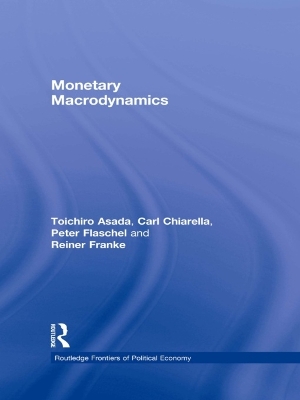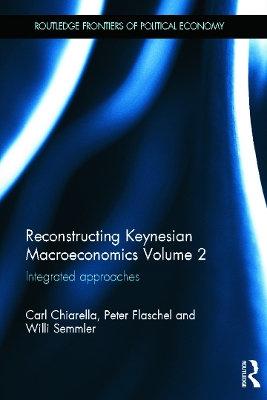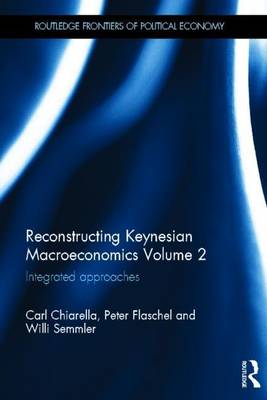Routledge Frontiers of Political Economy
1 primary work • 5 total works
Book 149
Reconstructing Keynesian Macroeconomics Volume 1
by Carl Chiarella, Professor Emeritus Peter Flaschel, and Henry Arnhold Professor of Economics Willi Semmler
This book represents the first of three volumes offering a complete reinterpretation and restructuring of Keynesian macroeconomics and a detailed investigation of the disequilibrium adjustment processes characterizing the financial, the goods and the labour markets and their interaction. It questions in a radical way the evolution of Keynesian macroeconomics after World War II and focuses on the limitations of the traditional Keynesian approach until it fell apart in the early 1970s, as well as the inadequacy of the new consensus in macroeconomics that emerged from the Monetarist critique of Keynesianism.
Professors Chiarella, Flaschel and Semmler investigate basic methodological issues, the pitfalls of the Rational Expectations School, important feedback channels in the tradition of Tobin's work, and theories of the wage-price spiral and the evidences for them. The book uses primarily partial approaches, the integration of which will be the subject of subsequent volumes. With its focus on Keynesian propagation mechanisms, the research in this book provides a unique alternative to the black-box shock-absorber approaches that dominate modern macroeconomics.
Reconstructing Keynesian Macroeconomics should be of interest to students and researchers who want to look at alternatives to the mainstream macrodynamics that emerged from the Monetarist critique of Keynesianism.
Monetary Macrodynamics
by Toichiro Asada, Carl Chiarella, Peter Flaschel, and Reiner Franke
This book investigates the interaction of effective goods demand with the wage-price spiral, and the impact of monetary policy on financial and the real markets from a Keynesian perspective. Endogenous business fluctuations are studied in the context of long-run distributive cycles in an advanced, rigorously formulated and quantitative setup. The material is developed by way of self-contained chapters on three levels of generality, an advanced textbook level, a research-oriented applied level and on a third level that shows how the interaction of real with financial markets has to be modelled from a truly integrative Keynesian perspective.
Monetary Macrodynamics shows that the balanced growth path of a capitalist economy is unlikely to be attracting and that the cumulative forces that surround it are controlled in the large by changes in the behavioural factors that drive the wage-price spiral and the financial markets. Such behavioural changes can in fact be observed in actual economies in the interaction of demand-driven business fluctuations with supply-driven wage and price dynamics as they originate from the conflict over income distribution between capital and labour.
The book is a detailed critique of US mainstream macroeconomics and uses rigorous dynamic macro-models of a descriptive and applicable nature. It will be of particular relevance to postgraduate students and researchers interested in disequilibrium processes, real wage feedback channels, financial markets and portfolio choice, financial accelerator mechanisms and monetary policy.
Reconstructing Keynesian Macroeconomics Volume 3
by Carl Chiarella, Professor Emeritus Peter Flaschel, and Henry Arnhold Professor of Economics Willi Semmler
This book represents the third of three volumes offering a complete reinterpretation and restructuring of Keynesian macroeconomics and a detailed investigation of the disequilibrium adjustment processes characterizing the financial, the goods and the labour markets and their interaction.
This book offers a full treatment of the interlinkages between the real and the financial markets, including an analysis of banking, credit, and endogenous money and asset markets. It remains critical of quite frequently used conventional macro models that have dropped the tradition of studying the macroeconomic feedback channels, well-known in the history of macroeconomics. Those feedback mechanisms are known to have the potential for instabilities with respect to real markets, price dynamics and financial markets. In this volume a particular emphasis is given to the financial-real interaction.
The research in this book with its focus on Keynesian propagation mechanisms provides a unique alternative to the black-box shock-absorber approaches that dominate modern macroeconomics. The main conclusion of the work is that policy makers need to reconsider Keynesian ideas, but in the modern form in which they are expressed in this volume.
Reconstructing Keynesian Macroeconomics will be of interest to students and researchers who want to look at alternatives to the mainstream macrodynamics that emerged from the Monetarist critique of Keynesianism. This book will also engage central bankers and macroeconomic policy makers.
Reconstructing Keynesian Macroeconomics Volume 2
by Carl Chiarella, Peter Flaschel, and Willi Semmler
This book represents the second of three volumes offering a complete reinterpretation and restructuring of Keynesian macroeconomics and a detailed investigation of the disequilibrium adjustment processes characterizing the financial, the goods and the labour markets and their interaction.
In this second volume the authors present a detailed analysis and comparison of two competing types of approaches to Keynesian macroeconomics, one that integrates goods, labour and financial markets, and another from the perspective of a conventional type of LM-analysis or interest-rate policy of the central bank. The authors employ rigorous dynamic macro-models of a descriptive and applicable nature, which will be of interest to all macroeconomists who use formal model-building in their investigations.
The research in this book with its focus on Keynesian propagation mechanisms provides a unique alternative to the black-box shock-absorber approaches that dominate modern macroeconomics. The main conclusion of the work is that policy makers need to reconsider Keynesian ideas, but in the modern form in which they are expressed in this volume.
Reconstructing Keynesian Macroeconomics will be of interest to students and researchers who want to look at alternatives to the mainstream macrodynamics that emerged from the Monetarist critique of Keynesianism. This book will also engage central bankers and macroeconomic policy makers.



